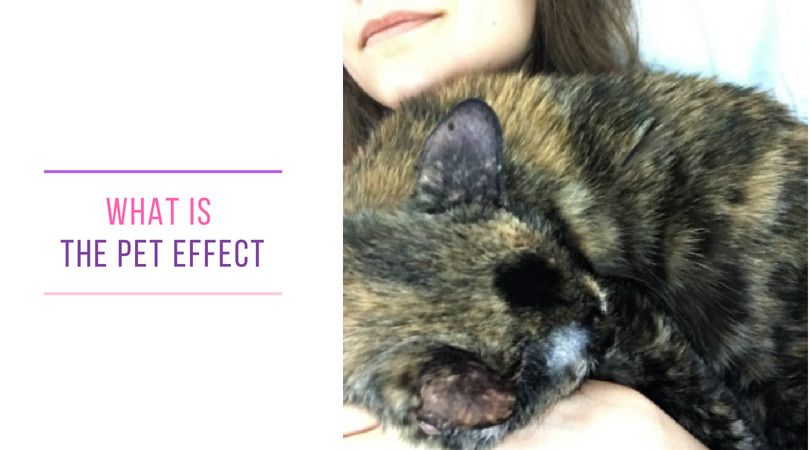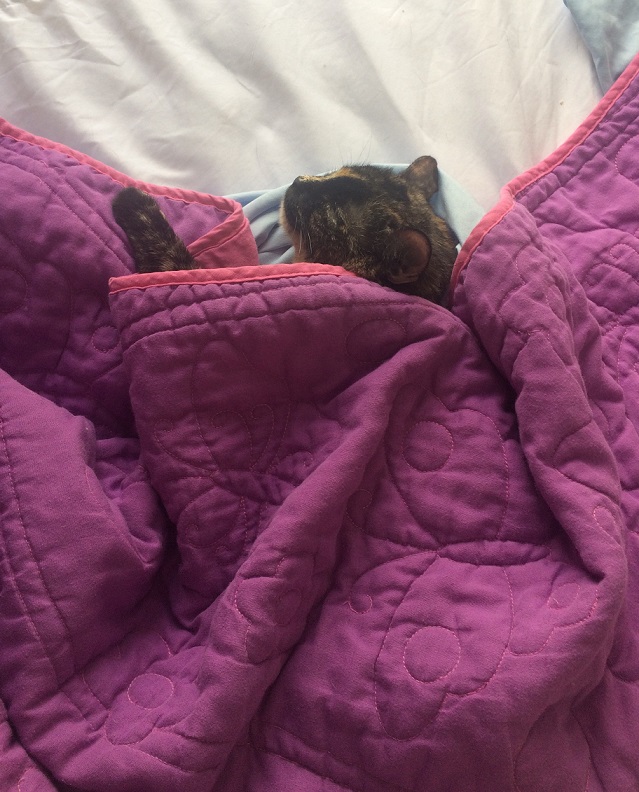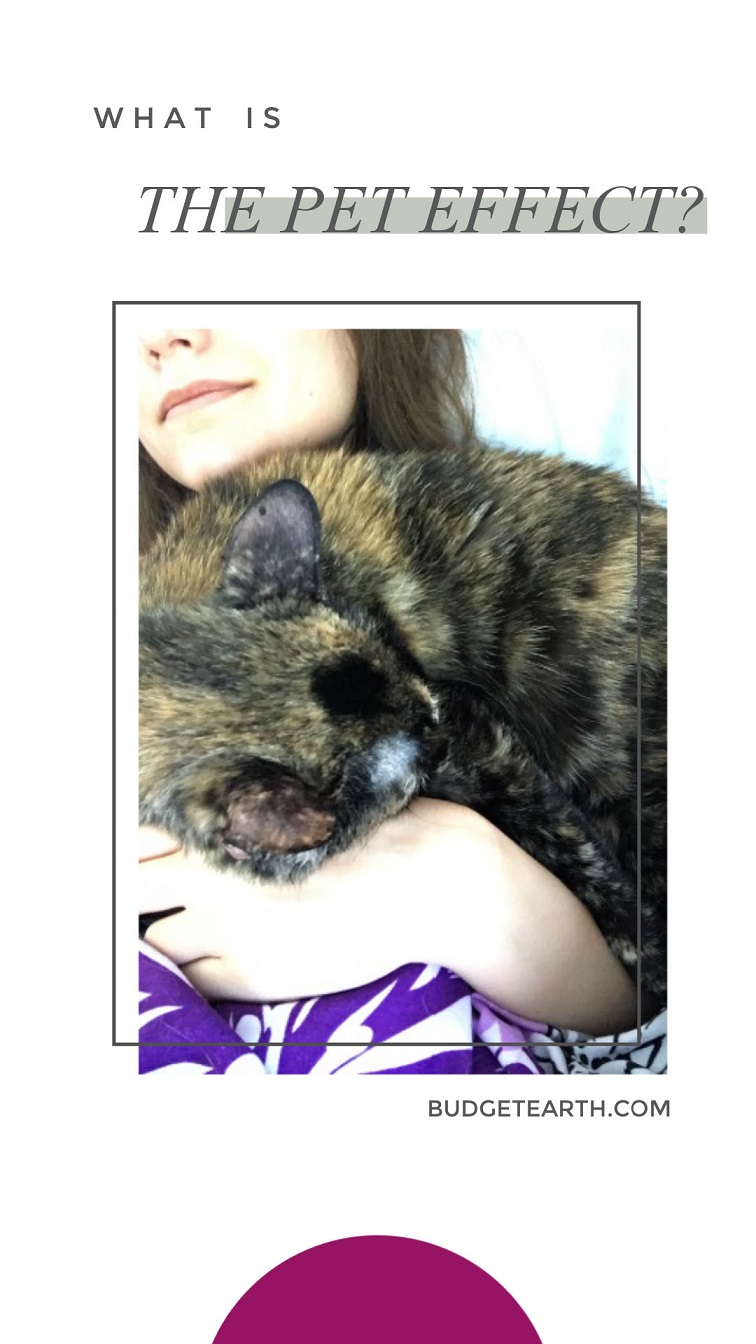
As many of you may or may not be aware, I’m the resident cat writer here at Budget Earth. My senior cat, Blaze, has lived with me for her entire life – that’s more than half of mine. I could gush to you about her loving personality, the way she chirps back to the birds outside our window in the morning, and her constant desire for affection and closeness, but something I’ve never really shared with you is how greatly she’s helped me through long bouts of anxiety and depression. I’ve struggled with both conditions since middle school, and through it all the animals in my life (but Blaze in particular) have served as support and loving companions.
The Pet Effect is nothing new. In fact, there is an entire site dedicated to helping educate pet owners on the health benefits of bonding with animals. While emotional support animals are becoming increasingly popular, and service dogs have long helped people with disabilities (everything from visual and hearing impairments to PTSD and diabetes), the everyday animals that we value in our homes can also be beneficial to our overall health and well-being.
Mental Health Management
A year ago, I was living with my brother in a place that I hated and I was in a relationship so stressful that it felt like it was crushing the life out of me. All of my friends lived hours away, and I was prone to anxiety attacks and feeling overwhelmed by hopelessness. On the days where I didn’t even want to leave my room, my cat cuddled up to me and my brother brought me his bunny to snuggle. The animals didn’t cure my anxiety or depression, but the simple act of grounding myself with them, petting them, and caring for them did help.
 The Pet Effect in action. Go ahead. Tell me you wouldn’t feel better after snuggling her…
The Pet Effect in action. Go ahead. Tell me you wouldn’t feel better after snuggling her…
Many animals flourish in an area where just as many humans don’t: being present. Dr. Ann Berger, a physician and researcher at the NIH Clinical Center in Bethesda, Maryland, explains it well: “If someone is struggling with something, they know how to sit there and be loving. Their attention is focused on the person all the time.” She elaborates on the mindfulness she teaches her patients to help decrease and manage their pain: “The foundations of mindfulness include attention, intention, compassion, and awareness. All of those things are things that animals bring to the table. People kind of have to learn it. Animals do this innately.”
Pets also provide security through generating a sense of order (continuity like “I need to feed my cat and scoop her litterbox,” or “the dog needs to be walked” daily) and providing a sense of meaning in an individual’s life. They provide distraction and disruption from distressing symptoms, like rumination or thoughts of suicide, and provide a sense of security and routine. Interestingly enough, pets don’t have to be cuddly to help. It’s the caring for another living creature that makes a difference.
Stress
Pets offer social support, serve as a major buffer against stress, and can help a person feel more relaxed. Although social support from friends and family can provide similar benefits, such relationships often also cause stress whereas animals may be less likely to do so. Pets may also encourage more social interaction, reducing feelings of isolation or loneliness. It’s not rocket science that when you walk a cute dog strangers are more likely to stop and talk to you!
Quality of Life
People who have pets tend to have lower blood pressure, heart rate and heart-disease risk than those who don’t. Pet owners have been found to report higher life satisfaction than non-owners, and for the elderly in particular, companion animals bring value, meaning, and worth to their lives. As previously mentioned, pets promote relaxation, provide social support, and can help individuals adhere to a daily schedule. Additionally, they can enhance an individual’s mobility (like walking or playing with a dog, or grooming a horse) and further well-being.
 Blaze also has a great quality of life. Maybe the Pet Effect works both ways?
Blaze also has a great quality of life. Maybe the Pet Effect works both ways?
Emotional Development & Social Skills
I remember my classroom in elementary school was home to a variety of animals: gerbils, hamsters, and even a tarantula. The best days, however, were “pet days” in which the students were allowed to bring pets from home to share. My family’s ferrets were always a huge hit, but unfortunately Blaze has never forgiven my dad for trying to take her for my little sister to share with the school. It’s interesting to note that studies have found that classroom pets lead to higher social integration, fewer aggressive children, and students’ improved attitudes toward school. A further consideration of the Pet Effect is that classroom pets facilitate students’ learning of lessons in responsibility, respect, and empathy.
Reading & Cognition
It may sound silly at first, but having a pet to read to has been found to be a motivating factor for children. The animals themselves do not judge, laugh, or criticize the child and they allow young readers to move at their own pace. In studies, children have reported liking the animal and finding enjoyment in reading to him or her, increasing their motivation to read.
The Bottom Line
Many health benefits may come from the extra exercise that playing and walking with a pet require, as well as from the stress relief of having a steady loving, nonjudgmental companion. More research is needed before scientists know exactly why the Pet Effect works and how much animal interaction is needed for the best results, but it’s evident that our furry (and non-furry) friends have a strong place in medicine and in our mental well-being.
 After all she’s done for me, I just hope I’m giving her the happiest, easiest life ever.
After all she’s done for me, I just hope I’m giving her the happiest, easiest life ever.


Pets aren’t for everyone, but some really need this extra friend.
I think it goes both ways, too. Animals are living creatures, just like people, and it can be easy to forget that they need more than just their physiological needs met. Love, compassion, and social interaction go a long way.
I love this post. Pets are so amazing! My son suffers from severe anxiety and when he’s about to have an anxiety attack one of my cats always senses it and goes to him, allowing him to calm down and usually avoid the attack.
Animals are really amazing that way. A lot of people seem to be under the impression that cats aren’t as feeling as dogs are, and I think that’s simply not true. I’m glad your son has such a special friend to help him.
I’m still looking to move, hopefully next year, as I do want a dog. It has been years since I’ve been able to have one, no pets of any kind where we are, they changed the by-laws, and can’t even dog-sit or cat-sit!
We have both a cat and a dog in our family. I can’t imagine not having them both here for cuddling every day. Both of them definitely are attuned to the emotions of everyone in the house and are expert level snugglers.
Same as you, I coudln’t imagine life without all of our pets. Ivi and Rylie are my big cuddlers though!
This is such a great post. I couldn’t imagine life without my pets. They are full of unconditional love.
Thank you! I can tell the love goes both ways. Your pets are lucky to have you. 🙂
When I rescued my cat Oskar he needed me as much as I needed him, he was so sickly and my main goal in life was to make him better, now 5 years later he is a 14lb love bug and I am so thankful he is in my life.
That’s such a lovely story, Holly! Oskar is so fortunate to have found you; it sounds like you’re perfect for eachother.